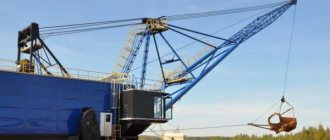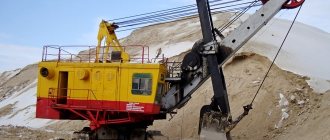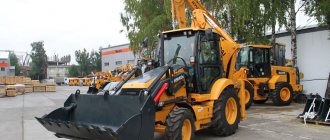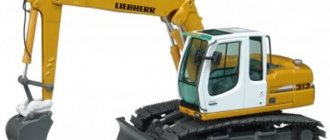Description of ECG excavators
Excavator ECG - decoding numbers and letters. The numbers in the model names indicate the volume of the bucket in cubic meters. The number is followed by a letter index indicating the manufacturer's improvement. For example:
- letter A - indicates the first update of the model;
- the letter U is an extended piece of equipment designed for top loading;
- the letter D stands for diesel;
- the letter N is the name of the Novokramatorsky Machine-Building Plant;
- letter I - Izhora factories.
Let's look at the description of the design. The excavator is not complicated. The machine has 1 scoop, moves on tracks, and the control cabin rotates freely around its axis. The main equipment is called a mechanical shovel.
This machine has proven itself well in the quarry; it is used to develop lands of various categories. The mining and coal industries cannot do without this technology. The machine digs up the soil during mining, performs loading operations, filling dump trucks with a dump.
Types of ECG excavators and main characteristics of the equipment.
EKG-5A excavators are designed as follows.
The chassis consists of the following elements:
The hydraulic system controls the brakes and clutches.
Rotating platform on which are installed:
- driver's cabin;
- winches;
- two-legged stance;
- 2 rotary mechanisms;
- pneumatic system (controls the brakes);
- electrical equipment.
The undercarriage is supported by a roller circle.
The pneumatic system is responsible for the rotation, pressure, and lift brakes. Blows dust out of equipment. All this works using compressed air from a 2-cylinder compressor.
The hydraulic system controls the chassis brakes.
High-voltage current receiver located between the lower and rotary frames.
ECG indicators
The main indicators of the electrocardiogram characterizing the work of the myocardium are waves, segments and intervals.
Serrations are all sharp and rounded bumps written along the vertical Y axis, which can be positive (upward), negative (downward), or biphasic. There are five main waves that are necessarily present on the ECG graph:
- P – recorded after the occurrence of an impulse in the sinus node and sequential contraction of the right and left atria;
- Q – recorded when an impulse appears from the interventricular septum;
- R, S – characterize ventricular contractions;
- T - indicates the process of relaxation of the ventricles.
Segments are areas with straight lines, indicating the time of tension or relaxation of the ventricles. There are two main segments in the electrocardiogram:
- PQ – duration of ventricular excitation;
- ST – relaxation time.
An interval is a section of an electrocardiogram consisting of a wave and a segment. When studying the PQ, ST, QT intervals, the time of propagation of excitation in each atrium, in the left and right ventricles is taken into account.
Specifications
- Engine - weighs 2 tons, Ag-M brand (200 kW);
- The total weight of the machine is 196 tons.
The machine is controlled from the operator’s cabin, which creates fairly comfortable working conditions. There are partitions that remove sound and vibration, good visibility. The cabin is equipped with air conditioning.
The ECG-5 line includes the following models:
- EKG-5V, in which the bucket teeth were replaced with hammers (pneumatic impact), which makes it possible to process the rock without preliminary explosions and drilling. Bucket capacity - 5 m³; scooping radius - 14.5 m; track width is 90x110x140 cm. This model is used in places where it is impossible to carry out explosions.
- EKG-5D, in which a diesel-electric engine is installed to load rock into a dump truck after development. The bucket volume is 4.6-6.3 m³; digging radius - 14.5 m; track width is 90x110x140 cm, operating weight is 195 tons. The fuel tank holds 3800 liters. It is designed for continuous daily operation of the machine.
- EKG-5A-US - the length of the working boom has been changed (increased) to facilitate work in high areas:
- scooping radius - 15.5 m;
- bucket volume - 4.6 m³;
- track length - 5.83 m;
- caterpillar width - 90x110 cm.
- working weight - 211 t; power of the network motor is 250 kW.
Excavator EKG-5A: electrical equipment. EKG-5A receives power from an external distribution device, the current flows through a high-voltage cable. The electrical circuit is single-line.
- cable cross-section - 3x16 + 1x6, for tropical climates - 3x25 + 1x10;
- rated voltage - 3000 or 6000 V;
- frequency - 50 or 60Hz;
- permissible voltage fluctuations are from 5 to 10%.
Electrical equipment consists of electric drives for auxiliary and main mechanisms, as well as lighting. The power consumption of the machine is 250-275 kW.
Current relay protection and calculation of used energy occurs at substations. Grounding is carried out to the quarry grounding loop using a cable core. The excavator has a device that monitors the state of the 220 V electrical network.
The bucket and all parts are made of wear-resistant materials that can withstand high loads and reliable operation.
The digging process is automated, which greatly facilitates the driver’s work and saves fuel. Key structures are made of alloy rolled steel, this increases the reliability of the equipment under any conditions.
Models ECG-10 and 18
Excavators EKG-10 - technical characteristics. Some changes have been made to the model:
- The shape of the bucket and the cutting angle have been changed, which promotes better penetration into the rock and speeds up the filling of the bucket;
- flanges are used to attach the bucket to the handle;
- helical gearboxes were replaced with planetary gearboxes;
- instead of the usual liners on the saddle bearing, adjustable rollers are used;
- a damper was used on the handle;
- An electric drum was installed to wind the cable.
Based on the EKG-10, 2 more models of excavators were created - EKG-10M and EKG-10R.
Excavators EKG-18. The technical characteristics and features of this sample have been changed as follows:
- cargo lifting capacity increased to 170 tons;
- pressure - up to 80 t;
- the running trolley, on which forged wheels are installed, has been changed;
- the tension axle was replaced with separate hydraulic jacks (previously there was 1 axle for 2 bogies);
- the section of the lower frame in the danger zone was made larger;
- increased the caterpillar drive power (from 110 kW to 220 kW);
- to improve digging conditions, the running frame was reduced in size by 130 cm;
- 2 teeth added to the bucket;
- The bottom of the bucket is lined with a more durable material, which prevents rapid wear.
The process of inspection and repair of single-bucket excavators is carried out in accordance with technological supervision.
When and who needs to undergo heart diagnostics?
The doctor prescribes this diagnostic test in the following cases:
- high blood pressure;
- chest pain, shortness of breath;
- dizziness or fainting;
- heart murmurs;
- heart rhythm is disturbed;
- rheumatism;
- diabetes.
An electrocardiogram is also prescribed in case of overdose of certain medications. An ECG is part of the examination during medical examination, prof. examination, pregnancy, preparation for operations.
This is not an exhaustive list of cases when an ECG is necessary. In addition, it is performed without a doctor’s referral.
General description of ECG series excavators
ECG - single-bucket, full-rotary, electromechanical machines of intermittent (cyclic) action.
The EKG working equipment is a “ straight mechanical shovel ” designed for digging soils that are located above the excavator parking level. Excavators of the ECG series are maneuverable and have simple controls.
The most popular ECGs are those with a small bucket capacity = 4-5.2 m 3 produced by UZTM. The second most popular are the EKG-8I excavators of Izhora Plants JSC.
In Russia, ECGs are produced at several machine-building enterprises: OMZ (United Machine-Building Plants), Mining Machines, KRASTYAZHMASH .
Modifications
The EKG-8I quarry crawler excavator has a number of auxiliary mechanisms that ensure repair and installation work. If necessary, the copy can be converted into an EKG-4u or EKG-6, Zus excavator. To do this, you only need to replace the working equipment (boom, arm, bucket, boom suspension). The main components are unified with the corresponding components of the EKG-4u, EKG-6, Zus excavator. Each excavator is supplied with sets of tools and spare parts. Weight of tools and accessories - 1,040 kg, spare parts (mechanical parts) - 7,400 kg, spare electrical equipment - 1,300 kg, counterweight (not supplied by the factory) - 27-33 tons.
ECG-5A at work
These powerful earthmoving machines are primarily used in heavy mining and processing industries, metallurgy and large industrial construction.
ECG-5A device
- ladle. The cutting edge of the bucket has 5 removable teeth, the bottom opens;
- handle (handle) of the bucket - 2 welded rectangular beams, goes into the boom by means of a connection;
- ropes that work to lift and open the bucket, lift the boom;
- boom with pressure system, bucket opening winch and blocks. The bottom point of the boom rests on the thrust bearings of the turntable; the rope pulley supports the top of the boom;
- rotating platform with driver's cabin, two-legged stand , winches (lifting, boom), 2 rotating mechanisms, electrical equipment, pneumatic system. The platform is connected to the undercarriage by a central axle and rests on it through a roller circle;
- running trolley. The lower frame, tracks, ring gear, final drive (with brake), hydraulic systems for controlling the brake and track clutches - all these mechanisms are part of the undercarriage;
- The high-voltage current collector is installed between the rotary and lower frames. The pneumatic system controls the brakes for lifting, turning, pressure, blowing electrical equipment, etc.
Technical characteristics of the EKG-5A excavator
- network motor Ag-M (250 kW), weight > 2 tons; in addition to the network motor, there are 3 more driving units: lifting, turning, stroke and pressure;
- weight = 196 t.
The technical characteristics of the electric all-wheel drive crawler shovel EKG-5A allow the machine to be used for excavation in heavy faces.
ECG-5 series models
- EKG-5V - bucket teeth are replaced with hammers, which avoids rock preparation in the form of explosions and rock drilling.
- EKG-5D - has a diesel-electric engine for loading rock into a dump truck after development.
- EKG-5A-US - working equipment of increased length for working in high faces, on ledges, loading rock into dump trucks (g/p = 75-110 tons).
QUARRY TRACKED EXCAVATOR EKG-8I DESCRIPTION AND TECHNICAL CHARACTERISTICS
QUARRY TRACKED EXCAVATOR EKG-8I DESCRIPTION AND TECHNICAL CHARACTERISTICS
The EKG-8I electric full-rotary excavator is designed for excavation and loading into vehicles or into a dump of minerals and overburden rocks in open-pit mining in ferrous and non-ferrous metallurgy, the building materials industry, the coal industry, as well as for performing large volumes of excavation work in industrial construction. The excavator manufacturer is OJSC Izhora Plants, St. Petersburg.
The EKG-8I excavator consists of working equipment, a rotating platform with mechanisms installed on it and a running trolley.
Working equipment
The working equipment includes a boom, a stick, a bucket with suspension, a mechanism for opening the bottom of the bucket and a boom suspension.
The articulated boom consists of a lower and upper section of a welded tubular structure. The boom takes the loads from the bucket with the handle and transfers them to the turntable and boom suspension. The handle is connected to the boom by a movably swinging saddle bearing. The bucket is suspended on a lifting rope that goes around the head blocks on the boom. The boom suspension is pivotally connected to a two-legged stand, which transfers loads from the boom to the turntable.
Rotary platform
The rotating platform serves as the basis for the excavator mechanisms and working equipment installed on it and, together with them, forms the rotating part of the excavator. The turntable frame is also the body of the excavator's counterweight. A lifting winch, a turning mechanism, a pressure winch, a compressor, an excavator body, and a driver’s cabin with controls are installed on the rotary platform.
Undercarriage
The turntable rests on a roller circle lying on the annular rail of the undercarriage and is connected to the undercarriage by a central axle. The undercarriage serves as a support for the entire rotating part of the excavator. Structurally, the undercarriage consists of a lower frame of a welded structure, a caterpillar track, running mechanisms for individual caterpillar drives and a ring gear with a roller circle.
Pressure mechanism
The pressure mechanism is used to impart reciprocating movement to the handle. The mechanism consists of a pressure winch and ropes.
The winch is driven by an electric motor connected to the gearbox by a friction clutch of the limiting torque. Drums are mounted on the output shafts of the gearbox.
Braking of the pressure mechanism during operation is carried out in countercurrent. To slow down the pressure mechanism when the machine is stopped and the excavator is de-energized, a pneumatic shoe brake is provided, unified with the brakes of the lifting mechanism.
Lifting mechanism
The lifting mechanism is used to raise and lower the bucket. The mechanism consists of a lifting winch and ropes. The winch is driven by two electric motors connected to the gearbox by two elastic couplings. Drums are mounted on the output shafts of the gearbox, on which lifting ropes are attached.
Braking of the lifting mechanism during operation is carried out countercurrently. To slow down the lifting mechanism when stopping the machine and de-energizing the excavator, two pneumatic shoe brakes are provided, unified with the brake of the pressure mechanism.
Swivel mechanism
The rotating mechanism of the excavator is used to rotate the turntable with mechanisms and working equipment. The rotation drive is carried out by two identical mechanisms, each of which consists of an electric motor and a gearbox. At the upper conical end of the shaft of each electric motor there is a brake pulley for a shoe brake, designed to slow down the turning mechanism when the excavator is moving, when parked and during an emergency blackout, and at the lower end there is a gear, which is the driving gear of the turning gear. The cantilever output shaft of the gearbox ends with a sliding gear engaged with a fixed ring gear located on the lower frame of the excavator undercarriage.
Pneumatic system
The pneumatic system is used to control the rotation, lift and pressure brakes, blow compressed air onto electrical equipment and mechanisms, control the entrance staircase, give a signal and drive various pneumatic tools.
The air is pumped by a compressor station, which consists of a BB-O7/8 compressor driven by an electric motor and two series-connected air collectors. The total volume of air collectors is 47 liters. An air filter is installed on the suction pipe of the compressor. An oil separator with a drain valve and a check valve are installed on the discharge pipe in front of the air collector.
Chassis
The running mechanism is used to move the excavator and consists of an electric motor, a brake, a gearbox and final drives of the caterpillar drive. The electric motor is installed on the gearbox housing, which is attached to the tracked frame, and is connected to it by an elastic coupling, which simultaneously serves as a brake pulley for the electromagnetic brake. What is new in the practice of domestic and foreign excavator construction for machines of this class is the installation of a separate drive on each track of the travel mechanism. The gears of all mechanisms are enclosed in dust-proof oil baths, and their shafts are mounted on rolling bearings.
The mechanisms located on the turntable (except for the pressure one) are covered by a metal body, which is equipped with forced ventilation and internal lighting. The driver's cabin, raised above the body, provides good visibility, is spacious, sealed, equipped with a heating system and window heating ventilation. The excavator has a number of auxiliary mechanisms that ensure repair and installation work. If necessary, the EKG-8I excavator can be converted into an EKG-4u or EKG-6, Zus excavator. To do this, you only need to replace the working equipment (boom, arm, bucket, boom suspension). The main components are unified with the corresponding components of the EKG-4u, EKG-6, Zus excavator.
The excavator receives power from a high-voltage switching point. The quality of power supply must be ensured by the consumer in accordance with the standards of the current regulatory and technical documentation. The power consumption of the excavator in half-hour mode is 250-275 kW with a weighted average power factor of 0.6. To power the excavator from the connection point, a high-voltage cable KShVG-Zx16+1x6 for temperate climate conditions or KShVG-T-Zx25+1xYu for tropical climate conditions is recommended.
To control the high-voltage electric motor Ag-M (five-machine converting unit) and the auxiliary power transformer Tr1, a small-sized high-voltage switchgear switchgear RU with a common disconnector, an oil switch for a trip current of 1.25 kA, having a manual drive, and fuses are used. 8 A or 16 A at a supply voltage of 6000 V or 3000 V, respectively.
Relay current protection, as well as protection against lightning overvoltages and metering of consumed electricity consumption is provided by the consumer at the electrical substation or at the switching point. The excavator body is grounded to the quarry grounding circuit through the grounding conductor of the KShVG cable. The electric motors of lifting, pressure, rotation, and travel are powered by a generator-motor system with direct current controlled by power magnetic amplifiers UK-UMSP, UK-UMSN, UK-UMSV by cam command controllers KKP, KKN, KKV. The control system includes blocks and assemblies that ensure the stability of the mechanical characteristics of the main drives when the temperature of electrical machines changes: current limiting blocks - UK-BTOP, UK-BTON, UK-BTOV; block for stabilization of excitation currents of main drive motors - UK-BSTV; automatic digging unit - UK-BAK. The excavator provides monitoring of the insulation state of the 220 V AC power supply network RU-R, as well as power and DC control circuits.
TECHNICAL SPECIFICATIONS
ECG modifications, main technical parameters
Quarry ECGs are produced with buckets with a volume from 4 to 46 m³. Modifications, for the most part, are made by the URALMASH plant.
Models with working equipment of increased length are designed for passing pioneer trenches and loading rock into road and rail transport, which can be placed higher than an excavator.
Technical characteristics of EKG-8I
There is only 1 model in the EKG-8 line - EKG-8I, the production of which began at the Izhora plant named after. Zhdanov in 1965 After 3 years, the model was assigned state registration. Quality mark.
EKG-8I is equipped with 2 buckets: the main one for heavy loads (8 m³) and the replaceable one for medium loads (10 m³).
Model ECG-8US is a modification of ECG-10. It is equipped with an extended boom for working off high benches and for moving railway tracks.
Lifting, pressure, rotation, stroke, and the bucket bottom opening system are powered by DC motors. The main electric motors receive power from a generator, auxiliary motors from a transformer.
Technical characteristics of ECG-10
Differences in the design of the basic ECG-10 model:
- the cutting angle and geometry of the bucket have been changed - this increases the filling capacity of the bucket and improves penetration into the rock;
- the bucket is attached to the handle using flanges;
- planetary gearboxes instead of spur gearboxes;
- adjustable rollers instead of liners on a saddle bearing;
- the handle is equipped with a damper;
- electric drum for winding cable.
The EKG-10 excavator with its technical characteristics has become the base model for the creation of 2 varieties:
- EKG-10M with a wider bucket (11.5 m) for use in coal mines;
- EKG-10R has a lifting force increased to 110 tons (instead of 100 tons). The turntable has plates and holes for mounting an in-line and planetary lifting gearbox.
Application
These powerful machines are used to advantage in the mining and processing industries. They are indispensable for digging soil and solid fractions, minerals. Excavators are satellites of mining, metallurgy, coal mining and the construction industry.
Despite their power, EKG-5A machines have dynamic handling, and their maintenance and service does not cause much trouble.
Among the manufacturers of EKG-5A excavators, the leading positions are occupied by:
- JSC "Mining Machines";
- JSC "Uralmash";
- JSC "Izhora Plants"
Device
The ECG-5A mechanism includes the main functional elements:
- bipedal stance
- boom and pressure mechanism
1 Boom 2 Arm 3 Bucket opening mechanism 4 Bucket
The components of the bucket are the front and rear walls, bottom, rocker arm and block. High-strength steel is used in the production of the bucket. Its body is connected with the bottom and rocker arm using fingers. The steel handle, through a connection, transforms into a boom on which a pressure system, blocks and a winch are installed. The boom is based on a rotating platform. It is on it that the dynamics mechanism, electrical system, body and rack parts are located. This complex is crowned by the driver's cabin. Next, let's look at the technical characteristics of the EKG-5A excavator.
The climatic conditions of quarry work require the production of several types of machines based on temperature fluctuations:
- For temperate climates (±40 °C) – “U”.
- For cold climates (+40 - −50 °C) - “HL”.
- For work in the Far North (+40 - −60 °C) - “C”.
- For tropical climates (+55 - −20 °C) - “T”.
Design features
- a rack-and-pinion pressure mechanism with a double-beam handle and an all-welded box-section boom ensures better mining of heavy rock faces of large-sized or poorly blasted rock masses;
- The bucket is lifted by rope, pulleyless type with automatic equalization of forces in the branches of the lifting rope;
- welded-cast ladle with wedge-type self-tightening teeth fastening. Free-falling bucket bottom with widely spaced hinges, eliminating dynamic contact with the handle;
- excavators are equipped with a lifting winch, which facilitates repair and installation work;
- ventilation units provide air injection into the body and create excess air pressure in the body;
- shoe-type brakes of the main mechanisms with a pneumatic drive for releasing the brakes;
- the undercarriage is two-track. An open, low-support type track with a separate drive for each track ensures accessibility for inspection and repairs. The drive wheels (“sprockets”), which have replaceable cams, are raised and freed from support reactions. The tension of the caterpillar tracks is carried out using built-in hydraulic cylinders. Forced ventilation is used on propulsion engines;
- The main metal structures of the excavator are made of alloy steel, the boom and handle are made of high-strength steel.
- the main mechanisms of the excavator have an individual adjustable electric drive;
- The automatic lubrication system reduces to a minimum the cost of maintaining the excavator during operation.
Specifications
Weight and size. EKG-5A is a medium-tonnage quarry-type shovel mechanism. Weight including counterweight is 197 tons. The width of the tracks is from 900 to 1400 mm. The bucket is capable of accepting from 4.6 to 6.3 cubic meters of bulk rock. Moving around the perimeter of the quarry, the machine reaches a speed of 0.55 km/h. The greatest slope when going uphill is 12o. The stroke length of the caterpillar mechanism is 5.83 m.
Lift-and-swivel. The length of the excavator boom is 10.5 m, the angle of inclination is 45°.
- Digging - the largest is 14.5 m, at the parking level 9.3 m.
- Unloading (largest) – 12.65 m.
The operator of the ECG excavator can rotate the platform around its axis. The turning radius is 5.25 m. The highest height from which rock excavation is carried out is 10.3 m. The bucket can rise at a speed of up to 0.87 m/s. The EKG-5A power plant allows you to develop a lifting force of up to 50 tf.
Duty cycle. The cycle of turning the excavator platform by 90° lasts 23 seconds. Platform rotation frequency – up to 3.5 revolutions per 1 minute. The pressure force at a constant speed of 0.45 m/s is 20.5 tf.
- Bucket characteristics:
- The type of bucket being installed is a backhoe.
- The smallest capacity of the installed bucket is 4.6 cubic meters.
- The largest capacity of the installed bucket is 6.3 cubic meters.
- The maximum digging radius is 14,500 millimeters.
- The maximum radius of unloading the bucket is 12650 millimeters.
- The maximum digging height is 10,300 millimeters.
- The maximum digging radius at ground level is 9040 millimeters.
- The maximum height of bucket unloading is 6700 millimeters.
- The total weight of the standard bucket is 9935 kilograms.
- The total length of the standard bucket is 2450 millimeters.
- The full width of the standard bucket is 2190 millimeters.
- The total height of the standard bucket is 2560 millimeters.
Engine:
- The type of engine installed is electric.
- The model of the installed engine is Ag-M.
- The structural weight of the engine is 2000 kilograms.
- The maximum output power is 250 kilowatts/339.9 horsepower.
Brake system
To control the braking system, rotation and pressure mechanisms, a pneumatic drive is installed on the excavator. It is also used to clean equipment. Control compressor – single-stage:
- Number of cylinders – 2.
- Feed rate – 580 liters per minute.
- Pressure – 0.7 MPa.
Dimensions:
- The total length of the handle is 7915 millimeters.
- The full width of the handle is 1774 millimeters.
- The total length of the stand is 6450 millimeters.
- The total width of the rack is 1400 millimeters.
- The overall length of the turntable is 8100 millimeters.
- The width of the turntable is 5000 millimeters.
- The overall height of the turntable is 1200 millimeters.
- The total length of the track frame is 5500 millimeters.
- The full width of the track frame is 750 millimeters.
- The total height of the track frame is 1000 millimeters.
- The total length of the lower frame is 3000 millimeters.
- The total width of the lower frame is 3000 millimeters.
- The total height of the lower frame is 1680 millimeters.
- The structural length of the cabin is 2360 millimeters.
- The structural width of the cabin is 1350 millimeters.
- The structural height of the cabin is 2760 millimeters.
- The width of the track shoes (option 1) is 900 millimeters.
- The width of the track shoes (option 2) is 1100 millimeters.
- The width of the track shoes (option 3) is 1400 millimeters.
- The lowest ground clearance under the turntable is 1890 millimeters.
- The smallest radius of the turntable is 6700 millimeters.
ECG interpretation algorithm
There is a scheme for deciphering an ECG with a sequential study of the main aspects of heart function:
- sinus rhythm;
- Heart rate;
- rhythm regularity;
- conductivity;
- EOS;
- analysis of teeth and intervals.
Sinus rhythm is a uniform heartbeat rhythm caused by the appearance of an impulse in the AV node with gradual contraction of the myocardium. The presence of sinus rhythm is determined by deciphering the ECG using P wave indicators.
Also in the heart there are additional sources of excitation that regulate the heartbeat when the AV node is disturbed. Non-sinus rhythms appear on the ECG as follows:
- Atrial rhythm - P waves are below the baseline;
- AV rhythm – P is absent on the electrocardiogram or comes after the QRS complex;
- Ventricular rhythm - in the ECG there is no pattern between the P wave and the QRS complex, while the heart rate does not reach 40 beats per minute.
When the occurrence of an electrical impulse is regulated by non-sinus rhythms, the following pathologies are diagnosed:
- Extrasystole is premature contraction of the ventricles or atria. If an extraordinary P wave appears on the ECG, as well as when the polarity is deformed or changed, atrial extrasystole is diagnosed. With nodal extrasystole, P is directed downward, absent, or located between QRS and T.
- Paroxysmal tachycardia (140-250 beats per minute) on the ECG can be presented in the form of an overlay of the P wave on the T wave, standing behind the QRS complex in standard leads II and III, as well as in the form of an extended QRS.
- Flutter (200-400 beats per minute) of the ventricles is characterized by high waves with difficult to distinguish elements, and with atrial flutter, only the QRS complex is distinguished, and sawtooth waves are present in place of the P wave.
- Flicker (350-700 beats per minute) on the ECG is expressed in the form of inhomogeneous waves.
Heart rate
The interpretation of the ECG of the heart must contain heart rate indicators and is recorded on tape. To determine the indicator, you can use special formulas depending on the recording speed:
- at a speed of 50 millimeters per second: 600/ (number of large squares in the RR interval);
- at a speed of 25 mm per second: 300/ (number of large squares between RR),
Also, the numerical indicator of the heartbeat can be determined by the small cells of the RR interval, if the ECG tape was recorded at a speed of 50 mm/s:
- 3000/number of small cells.
The normal heart rate for an adult is between 60 and 80 beats per minute.
Regularity of rhythm
Normally, the RR intervals are the same, but an increase or decrease of no more than 10% from the average value is allowed. Changes in the regularity of the rhythm and increased/decreased heart rate can occur as a result of disturbances in automatism, excitability, conductivity, and contractility of the myocardium.
When the automatic function is impaired, the following interval indicators are observed in the heart muscle:
- tachycardia - heart rate is in the range of 85-140 beats per minute, a short period of relaxation (TP interval) and a short RR interval;
- bradycardia - heart rate decreases to 40-60 beats per minute, and the distances between RR and TP increase;
- arrhythmia – different distances are tracked between the main heartbeat intervals.
Conductivity
To quickly transmit an impulse from the source of excitation to all parts of the heart, there is a special conduction system (SA and AV nodes, as well as the His bundle), the violation of which is called blockade.
- How to decipher an ECG analysis, norms and deviations, pathologies and diagnostic principles
There are three main types of blockades - sinus, intraatrial and atrioventricular.
With sinus block, the ECG shows a violation of impulse transmission to the atria in the form of periodic loss of PQRST cycles, while the distance between RRs increases significantly.
Intraatrial block is expressed as a long P wave (more than 0.11 s).
Atrioventricular block is divided into several degrees:
- I degree – prolongation of the PQ interval by more than 0.20 s;
- II degree – periodic loss of QRST with an uneven change in time between complexes;
- III degree - the ventricles and atria contract independently of each other, as a result of which there is no connection between P and QRST in the cardiogram.
Electric axis
EOS displays the sequence of impulse transmission through the myocardium and normally can be horizontal, vertical and intermediate. In ECG interpretation, the electrical axis of the heart is determined by the location of the QRS complex in two leads - aVL and aVF.
In some cases, axis deviation occurs, which in itself is not a disease and occurs due to an enlargement of the left ventricle, but, at the same time, may indicate the development of pathologies of the heart muscle. As a rule, the EOS deviates to the left due to:
- ischemic syndrome;
- pathology of the valve apparatus of the left ventricle;
- arterial hypertension.
A tilt of the axis to the right is observed with enlargement of the right ventricle with the development of the following diseases:
- pulmonary stenosis;
- bronchitis;
- asthma;
- pathology of the tricuspid valve;
- congenital defect.
Excavator EKG-5A
EKG-5A, the production of which began in 1980, is a tracked mining excavator with a bucket capacity of 5 cubic meters.
This technique is a kind of full-rotating quarry shovel with a caterpillar drive. It is designed to excavate overburden and minerals and load them into vehicles. EKG-5A is used in the construction industry and the coal industry. An excavator is used to perform significant volumes of excavation work. The technique also works with rocks, but they must first be loosened. The model is used in areas with a temperate climate and temperature conditions from -40 to +40 degrees. For digging soil, the EKG-5A is indispensable and is a constant companion in mining and metallurgy.
The equipment is quite easy to maintain and operate. The abbreviation EKG means “crawler quarry excavator”. The number following the name determines the capacity of the bucket in cubic meters. The remaining indices indicate the upgrade option or the code indicates a model with an extended working device).
Pathologies during ECG
The ECG is normal if all indicators are within a certain range. Otherwise, they speak of a deviation from the norm, but the presence of pathology must be determined by a doctor. Heart cardiogram decoding makes it possible to identify the following pathologies:
- Sinus arrhythmia suggests a physiological disorder, but is normal in children and adolescents.
- Atrial fibrillation can occur periodically or constantly, and is accompanied by a feeling in the patient of heart fluttering, anxiety, and panic.
- Sinus bradycardia, when the heart rate is about 50 beats per minute, is observed in healthy people during sleep and in athletes.
- Sinus tachycardia manifests itself in excess of the standard heart rate (90 beats per minute). In healthy people, it is temporarily observed during physical and emotional stress, drinking strong coffee, alcohol, and energy drinks. The pathology is indicated by a rapid heartbeat at rest.
- Extrasystole is characterized by a chaotic heartbeat, too frequent or too rare. Patients feel tremors behind the breastbone, tingling, empty stomach or sudden fear.
- Paroxysmal tachycardia manifests itself with periodic rapid heartbeat, while the pulse can reach 200-250 beats per minute. The duration of the attack can be from several minutes to several days.
- WPW syndrome is accompanied by a lack of air, a feeling of cardiac arrest for a moment, and a strong heartbeat.
Video
EKG-5A is an updated version of outdated versions of Uralmashplant products (EKG-4.6 and EKG-4.6A).
Excavator Features:
- gears and bucket are made of high-alloy wear-resistant materials, guaranteeing trouble-free operation even under significant loads;
- presence of a semi-automatic digging control unit in the control system. Automation of the process facilitates the operator’s work and reduces fuel consumption;
- key metal structures (lower and rotating frames, boom and handle) are made of alloy rolled steel. This ensures the reliability of the equipment even when working in difficult mining, geological and climatic conditions;
- The electric drive of the model is created according to the “generator-motor” system, with excitation from thyristor converters with electronic control, or with control through magnetic amplifiers.
Excavators EKG-5A are large-sized and heavy equipment. Their transportation is carried out by rail transporters or vehicles. During the transportation of the excavator, the two-legged stand is dismantled and the working equipment is removed.
In the line of Uralmashplant excavators, it is the EKG-5A model that is most widespread.
In addition to the basic modification of the EKG-5A, Uralmashplant produces modernized versions of the excavator:
- EKG-5V with pneumatic impact teeth suitable for breaking rock mass, and a pneumatic system that supplies the hammers with compressed air;
- EKG-5D with widened tracks and remote control system;
- EKG-5A-US with medium-extended parameters of working equipment. This model is used for excavating widened stopes.
Specifications
The capacity of the EKG-5A bucket is 5 cubic meters. The length of the excavator turntable is 8100 mm, height – 1200 mm, width – 5000 mm, weight – 18900 kg. The operating weight of the equipment is 19600 kg.
Other parameters of ECG-5A:
- largest scooping radius – 14500 mm;
- largest unloading radius – 12650 mm;
- scooping height – 10300 mm;
- scooping radius at standing level – 9040 mm;
- tail radius – 5250 mm;
- maximum unloading height – 6700 mm;
- specific ground pressure – 205 kPa;
Fuel consumption
The fuel consumption rate of the EKG-5A is 19 l/hour. At the same time, the equipment’s fuel tank holds up to 380 liters, allowing uninterrupted operation for 24 hours.
What does an ECG look like normally and with pathology?
Electrocardiogram parameters in adult men and women are presented in the table and look like this:
| ECG parameters | Norm | Deviation | Probable cause of deviation |
| RRR distance | Even spacing between teeth | Uneven distance |
|
| Heart rate | 60-90 beats/min at rest | Below 60 or above 90 beats/min at rest |
|
| Atrial contraction - R wave | Directed upward, outwardly resembles an arc. The height is about 2 mm. May not be present in ΙΙΙ, AVL, V1. |
|
|
| PQ interval | A straight line between the PQ teeth with an interval of 0.1-0.2 seconds. |
|
|
| QRS complex | Length 0.1 second - 5 mm, then T wave and straight line. |
|
|
| Q wave | Absent or directed downward with a depth equal to 1/4 of the R wave | Depth and/or width exceeding normal |
|
| R wave | Height 10-15 mm, pointing upward. Present in all leads. |
|
|
| S wave | Depth 2-5 mm, sharp end pointing down. |
| Left ventricular hypertrophy. |
| ST segment | Coincides with the distance between the ST teeth. | Any deviation of the horizontal line greater than 2 mm. |
|
| T wave | The height of the arc is up to 1/2 of the R wave or coincides (in the V1 segment). Direction - up. |
|
|
What kind of cardiogram should a healthy person have?
Indications of a good cardiogram for an adult:
- ECG changes in coronary artery disease (introductory review)
| Prong | Lead | Description |
| R |
| Positive. |
| R | AVR | Negative. |
| T | AVR | Negative. |
| R | V1-V4 | Increase in amplitude. |
| R | V5-V6 | Reducing the swing of oscillations. |
| S | V1-V6 | Reduction until complete disappearance. |
| RST segment | On the isoline. | Error no more than 0.5 mm |
The video compares the cardiogram of a healthy and sick person and provides the correct interpretation of the data obtained. Taken from the channel “Life of a Hypertensive”.
Indicators in adults
An example of a normal ECG in adults:
| ECG indicators | Norm |
| QRS | 0.06-0.1 sec |
| P | 0.07-0.11 sec |
| Q | 0.03 sec |
| T | 0.12-0.28 sec |
| PQ | 0.12-0.20 sec |
| Heart rate | 60-80 beats/min |
Indicators in children
Electrocardiogram parameters in children:
| ECG indicators | Norm |
| QRS | 0.06-0.1 sec |
| P | No more than 0.1 sec |
| Q | 0.2 sec |
| QT | No more than 0.4 sec |
| Heart rate |
|
Device
ECG-5A is constructed from several working units and parts:
- roller circle;
- a running trolley including a lower frame;
- running gear;
- pairs of track frames with wheels and track chains;
- ring gear.
These mechanisms are installed on a platform and covered by a body, the roof of which is equipped with removable panels, ensuring ease of installation and repair of components. Most of the components and mechanisms of the equipment are interchangeable and have a block design. This allows the use of the repair-aggregate nodal method.
The working equipment of the equipment is represented by a boom with a two-legged stand and a pressure mechanism, a bucket handle, a bucket opening mechanism and a bucket. The turntable bearing supports the lower end of the boom. The upper end is held by a rope pulley.
A lifting winch, a two-legged stand, two rotating mechanisms, electrical equipment, a body, a switch winch and a pneumatic system are mounted on a rotating platform. The driver's cabin is located on the right side of the platform, which, thanks to a roller circle, finds support in the undercarriage.
The EKG-5A bucket consists of front and rear walls, a cage with an equalizing block, a rocker arm and a bottom. The front wall is equipped with five removable teeth made of manganese steel. These elements are coated with hard alloy.
The running mechanism of the equipment is driven by an electric motor installed in the front part of the lower frame.
Design features of ECG-5A:
- rope lifting of a pulleyless type bucket with the function of automatic equalization of forces in the branches of the lifting rope;
- boom lifting winch, facilitating installation and repair work;
- rack-and-pinion pressure mechanism with an all-welded boom and a double-beam handle, ensuring optimal mining of rock faces;
- Shoe brakes with pneumatic drive;
- welded-cast bucket with self-tightening fastening of teeth;
- 2-track undercarriage with separate track drive;
- automatic lubrication system, which allows minimizing maintenance costs for the EKG-5A during operation;
- the main metal structures are made of high-strength and alloy steel;
- ventilation units support air injection into the body;
- the main mechanisms are equipped with an individual adjustable electric drive.
The equipment cabin is made taking into account ergonomic requirements. Its walls provide sound and heat insulation. The inside of the cabin is trimmed with decorative plastic. The vibration-isolated seat can be installed in any position convenient for the operator. The safety glass sun filter maintains optimal visibility while working. An electric heater and fan are also installed in the cabin.
Price new and used
Buying a new ECG-5A is quite difficult. Used versions from 1995-1997 are offered for 3.2-4 million rubles.
The cost of renting an excavator is from 1100 rubles/hour.
Brake system EKG-8I
Braking of the pressure mechanism during operation is carried out in countercurrent. To slow down the pressure mechanism when the machine is stopped and the excavator is de-energized, a pneumatic shoe brake is provided, unified with the brakes of the lifting mechanism. The lifting mechanism is used to raise and lower the bucket. The mechanism consists of a lifting winch and ropes. The winch is driven by two electric motors connected to the gearbox by two elastic couplings. Drums are mounted on the output shafts of the gearbox, on which lifting ropes are attached.
Braking of the lifting mechanism during operation is carried out countercurrently. To slow down the lifting mechanism when stopping the machine and de-energizing the machine, two pneumatic shoe brakes are provided, unified with the brake of the pressure mechanism. The rotary mechanism is used to rotate the turntable with mechanisms and working equipment. The rotation drive is carried out by two identical mechanisms, each of which consists of an electric motor and a gearbox. At the upper conical end of the shaft of each EKG 8I electric motor there is a brake pulley for a shoe brake, designed to slow down the turning mechanism when the machine is moving, when parked and during an emergency blackout, and at the lower end there is a gear, which is the drive gear of the turning gear.
Photo source: EKG-8I The capacity of the main EKG-8I bucket is 8 cubic meters
The cantilever output shaft of the gearbox ends with a sliding gear engaged with a fixed ring gear located on the lower frame of the machine's undercarriage. The pneumatic circuit is used to control the rotation, lifting and pressure brakes, blowing compressed air onto electrical equipment and mechanisms, controlling the entrance staircase, giving a signal and driving various pneumatic tools.
The air is pumped by a compressor station, which consists of a BB-O7/8 compressor driven by an electric motor and two series-connected air collectors. Such a technical characteristic as the total volume of the air collectors is 47 liters. An air filter is installed on the suction pipe of the compressor. An oil separator with a drain valve and a check valve are installed on the discharge pipe in front of the air collector. The running gear is used to move the machine and consists of an electric motor, brake, gearbox and caterpillar final drives. The electric motor is mounted on the gearbox housing, which is attached to the tracked frame, and is connected to it by an elastic coupling, which also serves as a brake pulley for the electromagnetic brake.
What is new in the practice of domestic and foreign excavator construction for machines of this class is the installation of a separate drive on each track of the travel mechanism. The gear transmissions of all EKG 8I mechanisms are enclosed in dust-proof oil baths, and their shafts are mounted on rolling bearings. The mechanisms located on the turntable (except for the pressure one) are covered by a metal body, which is equipped with forced ventilation and internal lighting. The driver's cabin, raised above the body, provides good visibility, is spacious, sealed, and equipped with a heating, ventilation, and heated glass system.
Photo source: techstory.ru Photo ECG-8I











